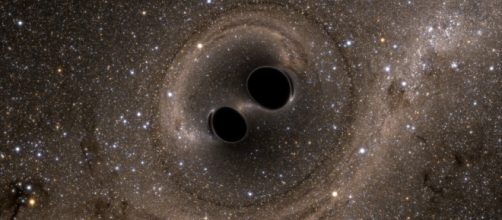Two US gravitational wave detectors are in operation and have confirmed the existence of Gravitational Waves but until a third such detector is operational and scientists can triangulate the sources they detect there is no way to pinpoint the source closely enough that optical instruments can be used to study the event.
Gravity waves
Gravitational waves are like the ripples you see in a calm pond when you toss a pebble into the water. The circular wave fronts spread out in every direction in two-dimensions and gravity waves spread out in three dimensions at the speed of light.
Einstein’s theories which have been confirmed so many times and in such great detail that modern astrophysics relies heavily on them, but until recently it wasn’t possible to detect gravitational waves which his theories predict would be generated when massive bodies such as stars or black holes collide.
Since the discovery that a supermassive black hole sits at the center of most galaxies, including our own Milky way galaxy, and that there are wandering black holes drifting through space, the ability to detect these objects has become of prime importance to scientists.
But this isn’t just an abstract curiosity, gravitational waves are the only way to study some aspects of gravitation, a weighty subject indeed as we attempt to colonize space.
US LIGO detectors
The two US-based detectors are in Livingston, Louisiana, and Hanford in Washington State.
LIGO stands for Laser Interferometer Gravitational-Wave Observatory and is essentially a greatly enlarged version of the old Michelson-Morley interferometer experiment which disproved the existence of ether and helped bring us the electronics revolution of the last century.
These observatories each consist of two long (2.5 mile) ultra high vacuum pipes set at right angles which carry a laser beam out and reflect it back to the source where the two beams are compared. Sounds simple enough but the physical size and precision necessary make it a tricky task.
From 2002 through 2010 nothing was detected but then the facilities were upgraded.
The main problem is that even waves on a nearby beach (nearby could be 500 miles) create vibrations in the earth and the detectors must be completely isolated from that kind of interference. Remember they are trying to detect two black holes colliding perhaps 1000 light years distant.
The LIGOs can currently detect events up to 260 million light-years (80 megaparsecs) distant.
The two detectors are about 1900 miles apart so the maximum time between a wave hitting one and then the other is on the order of 10 milliseconds. The precise time difference can be used to determine the direction of the event being detected but a third one is necessary to pinpoint the location.
European Gravitational Observatory
The European detector (located near Pisa Italy) encountered difficulty when the tiny 0.4mm glass fibers used to support the 88-pound mirrors began to break. They are incredibly strong for their tiny size but it was found that if a speck of dust lands on one it will cause a fracture and eventual failure. They were replaced with less effective metal wires and the calibration process is now taking place.
Besides the delay in going to full operation, which will probably mean it will miss this Summer's LIGO test, the EGO will only be sensitive enough to measure events up to 50 megaparsecs or 152 million light-years distant.

